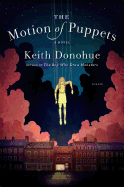
With The Motion of Puppets, Keith Donohue (The Boy Who Drew Monsters) evokes a bizarre underworld with an array of mythological references in a story of lovers seeking reunion. Newlyweds Kay and Theo Harper have come to Quebec for the summer, where she works as an acrobat in a cirque and he wrestles with a work in translation between semesters teaching French literature in New York City.
A puppet shop in Quebec's Old City draws Kay's attention daily, but the door is always locked, the lights off. One night, when returning from a party after midnight, she fears she is being followed and, finding the door unlocked for once, slips inside. Theo contacts the police when she does not return home, but no trace can be found of her. The rest of The Motion of Puppets alternates between their two experiences. Theo searches Quebec all summer for his wife, then returns to New York City and his work, distracted and mourning. Meanwhile, Kay adjusts to new circumstances: she has become a puppet.
This dreamy, sinister novel alludes widely to history, literature and legend. Theo's translation project is a biography of the photographer Eadweard Muybridge, whose work involved scientific knowledge of human and animal locomotion. Most pointedly, however, Kay's predicament is a reference to the myth of Orpheus and Eurydice, in which Orpheus misses his wife so terribly that Hades agrees to let her leave the underworld and return to life with him, under one diabolical condition.
An engrossing novel of love, fancy and enchantment, The Motion of Puppets offers a perfectly wrought moodiness, detailed settings and an unsettling plot. --Julia Jenkins, librarian and blogger at pagesofjulia

